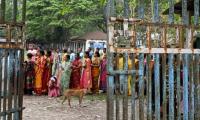To say education is important is an understatement. Historically, enlightened education has been one of the constants of every successful civilization.
From the Athenian and Roman civilizations to the Muslim and modern Western civilizations, there is not a single exception that progressed without an enlightened education.
Pakistan is certainly not an outlier to this either. To have lasting sustainable growth in Pakistan, the need for modern and equipped education is an inescapable conclusion from history.
Currently, the education system in Pakistan is a tale of unfulfilled expectations and regressive growth. After the 18th Amendment, Article 25-A ensures the right of free basic education for every Pakistani citizen in the age bracket of 5-16. However, when there are 22.8 million (44 percent of that age bracket – second highest in the world) instances of violation to this article each day, who will intervene to prevent this? Rhetorically, do provinces have the capacity to fill such a huge gap in policy commitment and actual implementation?
The challenges in the education sector in Pakistan are quite multifaceted. Even within the current capacity of budgetary allocation and infrastructure, the problems in this sector are deep-rooted. First, the divisive, highly regulated and agenda-based curriculum is destroying the innovative capability of students rather than nurturing it. Recently, the invitation to religious clerics by the government to regulate the contents in biology textbooks certainly shows regressive scientific growth.
Moreover, the wish to preserve the past (by glorifying warriors) rather than a hope to ensure a bright future dominates the minds of our educators. In the words of Bertrand Russell, such a curriculum endeavors to form habits and circumscribe knowledge in such a way as to make one set of opinions inevitable. Pervasive intolerance, impatience, and jingoism in Pakistan are the inevitable results of having such a curriculum.
Second, based on transmission rather than transformation, the pedagogical standards are quite outdated and detrimental, thereby making schools houses of detention, not attention. Unfortunately, some of our schools even lack walls to support blackboards, while the world has now shifted to smart boards and 3D demonstrations in classes.
Third, the worm-eaten and outdated system of recall-based assessment is still prevalent. Such a system hinders the growth of critical analysis among students, a trait that Will Durant rated as the ultimate desirable goal of education. No wonder this system generates a highly susceptible and agreeable generation that lacks basic curiosity, the cornerstone of creativity and innovation.
Above all, as recently highlighted by Moeed Yousaf, there are three parallel and largely disconnected education systems: public and non-elite schools, elite private schools, and religious seminaries, engaging 67 percent, 28.7 percent and 4.3 percent of the total student body, respectively. Consequently, such divergent outlooks, with hugely disparate future inspirations among these three cohorts, make it virtually impossible to forge a consensus on any issue of national or international importance. They say education is a greater equalizer, which apparently does not seem to be the case.
Lastly, political instability and lack of national consensus on educational policies in Pakistan have caused the sector to be the victim of short-termism and isomorphic mimicry (choosing ‘form’ over actual functional performance) just to win the game of having more inauguration stone boards.
Since the challenges are multipronged, the solutions need to be overarching. Even after the 18th Amendment, the federation should still act as a co-guarantor of equitable education across provinces. A federal-level policy framework should be devised to incentivize provinces through a premium on the NFC Award, conditioned on educational achievements. Such an approach can help the federal government alleviate the disparities across genders, rural-urban differences, and provincial gaps in education access.
Secondly, a holistic intervention is required to change curriculum, pedagogy, and assessment methodologies simultaneously. Just like the National Action Plan, political and non-political institutions should have a national consensus on educational policies; applicable across governments.
Thirdly, to ensure maximum enrolment in primary and secondary classes, each province should devise incentivization plans. One such possibility is a conditional cash transfer programme. Various countries like Mexico, Colombia, and Brazil have already successfully tested such a programme.
In the context of Pakistan, such an initiative can be incorporated with already running projects like the ‘Ehsaas’ programme with an established database.
Lastly, Pakistan needs to see the immediate future as an emergency-based corrective phase to bridge the gap between the theoretical policy framework and actual implementation. A laser-focused national effort is required to revamp this worm-eaten education system to achieve a unified, coherent, and integrated national education policy.
Currently, the education system is creating more problems than providing solutions for marginalization, deprivation, and radicalization among the youth. And being a country with such a huge youth bulge is virtually a survival threat for Pakistan.
In essence, educational advancement should be treated as a strategic imperative rather than just an optional development priority. Asia is in the midst of geographical transition and now steadily recovering from Covid-19; investment in education and human capital is the only chance for Pakistan to rise like a phoenix from the ashes.
The writer is a LUMS alumnus, an independent writer, artist and a social worker.
Email: ahmadzafar03@outlook.com
A woman walks past a building of the International Monetary Fund. — AFP/FileThe annual and spring meetings of the...
Late Benazir Bhutto's daughter Asifa Bhutto Zardari addresses the Christian community in Bihar Colony on January 23,...
Representational image. — PexelsWater is an important scarce natural resource that is required for several everyday...
Pakistani employees of online marketplace company Kaymu at work in Karachi. — AFP/FileThe true spirit of development...
India uses Afghanistan as a backstage area to carry out terrorist attacks against Pakistan
Another report by the Pakistan Institute of Peace Studies states that 78 per cent of attacks have been carried out by...







